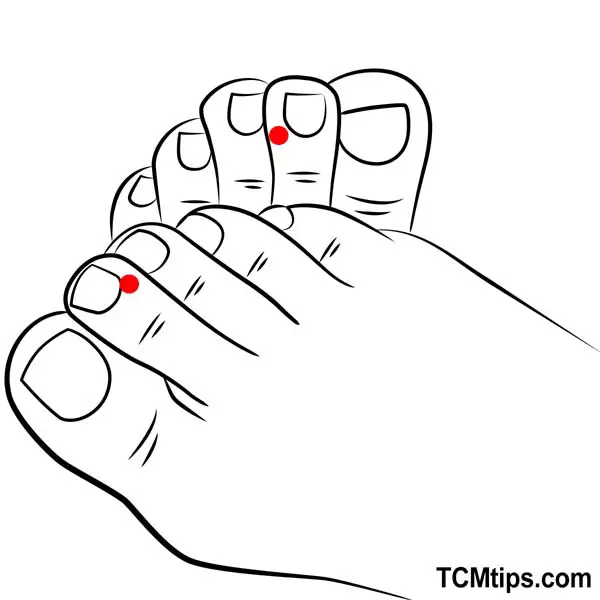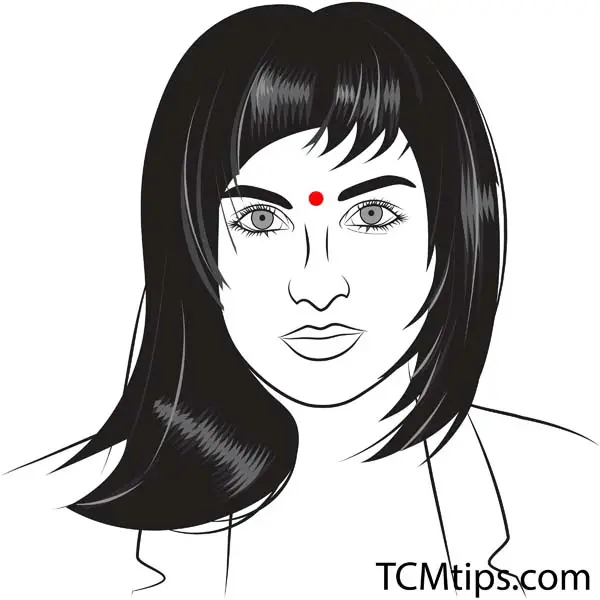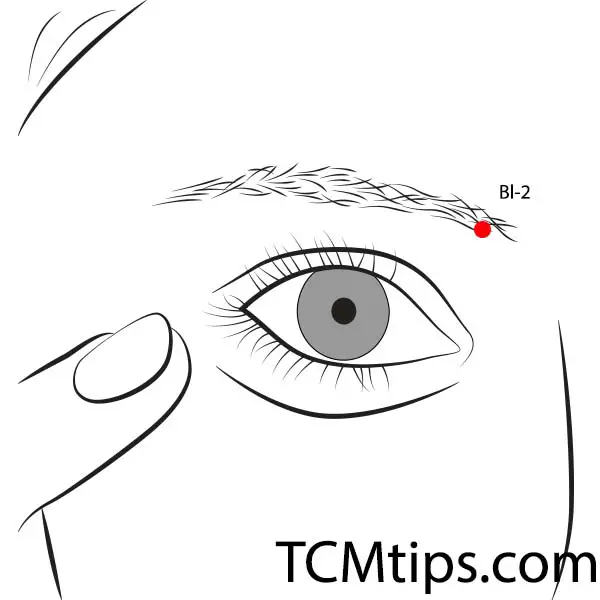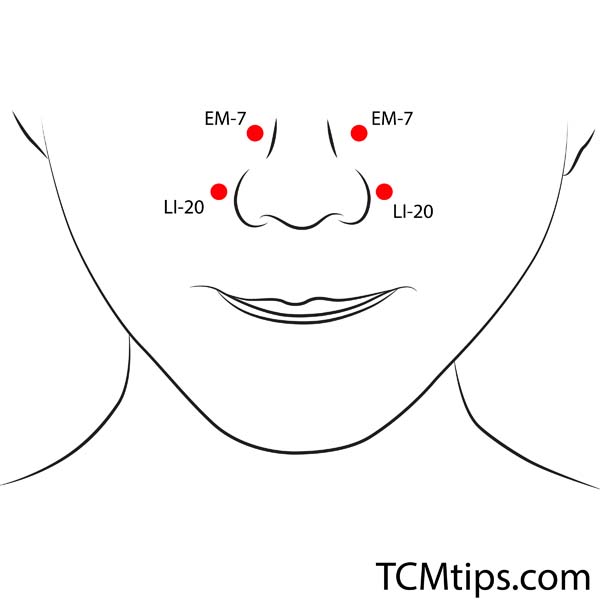Some time ago, I had a sinus infection and couldn’t sleep well because my nose was stuffy and runny. It was going on for two weeks and my face was beginning to hurt terribly, so I decided to seek a solution to my problem. I went to my doctor and he explained to me that I could use certain pills to stop it or use acupressure for sinus infection.
Being that I hated pills and injections, any other alternative was welcome. However, I didn’t trust that from the comfort of my house, I could heal myself from sinusitis by simply applying pressure to certain acupressure points on my body.
To allay my fears, my doctor explained to me that sinusitis is a common medical condition. Every year in the USA about 35 million people get sinus infection. Sinusitis patients get sinus infections mostly from the common cold, deficiencies of the immune system, narrowed ducts due to structural differences, and nasal polyps.
He said that although the situation can become critical, its treatment is not so complex. Alternative medicine like acupuncture and acupressure can take care of sinus infection effectively and save me some good dollars that would’ve been spent on pills.
I subscribed to acupressure and he showed me the pressure points for sinus allergies that I’m sharing with you in this article. I am certain it’s going to work wonders for you the way it did for me, but first, let me answer some questions you may be asking.
Can Acupuncture Help With Sinus Infections?

Yes, acupuncture is effective for many sinus problems such as nasal congestion and headaches. Researchers have found that among the over 300 licensed acupuncturists in the USA, 99 percent have treated patients with sinus and nasal problems.
Acupuncture therapy is a Traditional Chinese Medicine procedure that operates based on the concept of Qi, which means energy. Qi moves in the body through meridians and keeps the body balanced. However, when the flow of Qi is cut short, usually by health conditions, your emotional and physical health is hampered.
Acupuncture therapy then clears up the blockage of Qi by targeting acupuncture points on your skin, based on your symptoms, that are responsible for restoring the flow of Qi in the body.
Can Acupuncture Drain Sinuses?

The way acupuncture for sinus problems functions is to drain the symptoms of sinuses from the body. Acupuncture focuses on the root cause of a problem to restore the flow of energy in the body. So, in the case of allergic rhinitis or chronic sinusitis, acupuncture therapy targets its root cause and frees up the sinus once and for all.
First, it opens the nose. Then, it reduces congestion and pain in the sinuses. In most cases where acupuncture is used for sinus issues, you feel these improvements almost immediately, which makes it more effective than western medicine.
Also, because acupuncture has anti-inflammatory effects on the body, you’ll find that the inflammation in your sinus cavities is reduced once you’re undergoing the therapy.
In addition, acupuncture procedures free up blockages in the Qi and improve the movement of fluids in the body. So, when applied to sinus problems, it blears up congested mucous in the nasal cavity and helps you breathe better.
Does Acupressure Work For Sinus Problems?

Yes, like acupuncture, acupressure is also effective for treating sinus problems. The 2006 study earlier cited found that of the 300 licensed acupuncturists in the USA, 99 percent have treated patients with sinus and nasal problems by using acupressure and acupuncture procedures. This affirms how effective acupressure for sinus infections is.
However, another research in 2018 reviewing four academic works on the use of acupressure for the treatment of respiratory allergies had an inconclusive result. This goes to show that more research is needed for acupressure for sinus infection as there are more studies confirming acupuncture for sinus issues than acupressure.
Nonetheless, this doesn’t make acupressure less effective for treating sinus headaches, inflammation, and allergies. My doctor recommended acupressure for my sinus infection and it worked like a charm. I believe it will work for you too.
The Acupressure Points For Sinus Infection
Let’s dive into the pressure points for sinus allergies that my therapist disclosed to me and how you can massage these points for instant relief.
Acupoint: LI-4 (Other Names: Large Intestine-4/He Gu/Joining Valley)

LI-4, known as He Gu in Chinese or Joining Valley in English, is one of the effective pressure points for sinus allergies even though it is not located in the head. It is an acupressure point of the large intestine meridian that is located in the hand. He Gu is located at the back of your hand, half-inch away from the crease where your thumb connects to your hand. So, it is between your thumb and your hand.
Notwithstanding that it is an acupressure point when it comes to acupressure for sinus infection, LI-4 also has a versatile use. It is used to treat headaches, strained eyes, mental depression, and frustration. Although it is located in the hand, it is best for treating any medical condition related to the head. It is one of the acupressure points for sore throat.
Research from the journal of Orofacial Pain shows that Li-4 relieves myofascial pain of the jaw muscles when stimulated.
To stimulate this pressure point for sinus allergies, first, locate the point by holding your hands up such that you’re looking at the back of your hand. Locate that point where the muscle between your thumb and finger protrudes and apply pressure to it. Do this using your other hand for three minutes.
Acupoint: ST-45 (Other Names: Stomach-45/Li Dui/Running Point)

ST-45 is another acupoint of importance when it comes to acupressure for sinus infection. In Chinese, it is referred to as Lidui, which interprets as Sick Mouth in English. It is located on the foot, just on the index toe, by the corner of the nail line.
Although ST-45 is a sinus pressure point in the feet, it is connected to the nostrils, which makes it effective in treating runny noses and rhinitis.
When you stimulate ST-45, you clear the heat resident in the stomach meridian, steady the Shen, and bring yourself back to consciousness. For this reason, St-45 is very effective in treating toothaches, sore throat, any swelling on the face, and nightmares.
Acupoint: LI-20 (Other Names: Large Intestine-20/Ying Xiang/Welcome Fragrance)

LI-20 is another large intestine acupressure point that is effective for sinus problems. In Chinese, it is referred to as Yingxiang which means welcome fragrance. Unlike LI-4, this pressure point for sinus allergies is located on the face. You’ll find it on either side of your nostrils, at the point where your nose joins your cheeks.
LI-20 is the right acupoint to stimulate when you have nasal congestion, epistaxis, and an itching face. LI-20 is also one of the acupressure points for facelift like a pro. To stimulate LI-20, locate the point on your face, place a finger on both points on your face, and press them for three minutes.
Acupoint: EM-2 (Other Names: Yin Tang/Hall of Impression)

EM-2 or Yintang as it is called in Chinese is another vital acupoint when it comes to acupressure for sinus infection. It is one of the pressure points for sinus allergies that is located on the face. You’ll find it on your forehead, at the central point between your eyebrows. Because of its location, EM-2 is sometimes called the third eye.
Clinically, Yintang cures headaches, vertigo, rhinorrhea, infantile convulsion, and even insomnia. EM-2 also serves as an acupressure point for teeth grinding.
To stimulate this acupressure point for sinus issues, locate the point at the center of your forehead, between your eyebrows, and apply pressure to it using either your middle or index finger. Press down on this point slowly for five to ten seconds and release the pressure slowly. Repeat this motion five to six times for instant relief.
Acupoint: GV-23 (Other Names: The Governing Vessel-23/Shang Xing/Upper Star)

GV-23 or Shangxing as it is called in Chinese medicine is another effective acupressure point for sinus infection. You can locate it by tracing the line in the middle of your face up to the tender point 2 centimeters (or 1.0 cun) behind your hairline.

Shangxing functions well in dispelling wind, opening the nose, and unlocking benefits to the eye. This is why it is an acupoint when it comes to acupressure for sinus infections. Clinically, GV-23 cures headaches, rhinorrhea, pain in the eyes, apoplexy, and manic psychosis.
To stimulate this acupoint for sinus problems, locate the point on your head and push it. Don’t apply so much force while pushing it. Push it moderately for a few minutes and stop.
Acupoint: Bl-2 (Other Names: Urinary Bladder-2/Zan Zhu/Gathered Bamboo)

BL-2 is a bladder meridian acupoint that is also effective for treating sinus problems. It is called Zanzhu in Chinese or Bamboo Gathering in English, and like most of the other pressure points for sinus allergies, it is located on the face. You’ll find it in the depression at the middle-end of your eyebrow, just above your eye socket.
Clinically BL-2 is effective in treating any swelling around the eye, eye pain, blurred vision, hiccup, and diaphragm spasm. It is also an effective acupressure point for dry eyes.
To stimulate BL-2 for sinus infection, first, locate the with both hands by moving your fingers into the tiny depressions between your eyebrows and nose. Then, apply pressure on your brow bone, where your fingers must be resting already. Do this for a few minutes and let go.
Acupoint: EM-7 (Other Names: Bi Tong)

EM7 or Bitong, as it is popularly called, is another very vital acupoint to take note of when you’re settling for acupressure for a sinus infection. It is located on the face. You can find it by locating the base of your canines on your face, at the dents on both sides of your nose.
Because of its location, Bitong is very effective for issues related to the nose. So, it is clinically effective in treating sinusitis, allergic rhinitis, and headaches. Bitong, and Lu 9 acupuncture point, is effective for cough and nasal congestion.
Massage this point gently for a few minutes to improve any allergy of the nose you have.
Acupoint: SI-3 (Other Names: Small Intestine-3/Hou Xi/Back Stream)

SI-3 is a small intestine meridian acupoint that is very effective in relieving sinusitis. It is referred to as Houxi in Chines which translates to Back Stream. To locate this acupoint, make a loose fist, then trace the point at the fifth middle finger joint, just around the ulnar area, at the junction where red and white skin meets.
While the SI-3 acupuncture point is an active pressure point for sinus allergies, it also cures pain in the head and neck as well as those in the lumbar and sacrum. You can also use it to treat eye congestion, deafness, and manic psychosis.
Acupoint: ST-8 (Other Names: Stomach-8/Tou Wei/Head’s Corner)

The last acupressure for sinus infection that is worthy of note is ST-8. It is called Touwei in Chinese, which means Head Support in English. You’ll find this acupoint on both sides of your scalp, just above your hairline, by the corner of your forehead, 4.5 cun away from the midline of your head.
Because of its location, ST-8 is effective in treating headaches, blurry vision, ophthalmalgia, and twitching eyelids. Stimulating this point will relieve you from pains, discharge wind, and help your eyes.

Try our Anti-Aging Gua Sha Tool designed to bring out your skin’s natural glow.
Best Gua Sha Product- Anti-Aging: The tool is designed to target 11 specific aging signs such as wrinkles and sagging skin. By following the 7-step routine, users can improve skin firmness and reduce fine lines naturally.
- Enhances Skincare Routine: It works effectively with serums and lotions, boosting absorption and efficacy of skincare products.
- Visible Skin Improvement: Users can expect a smoother complexion, reduced puffiness, and a more youthful appearance.
 P. Sze
P. Sze 

















